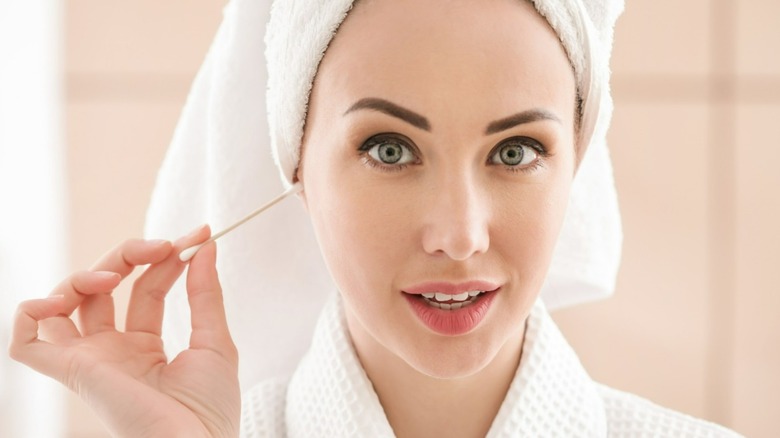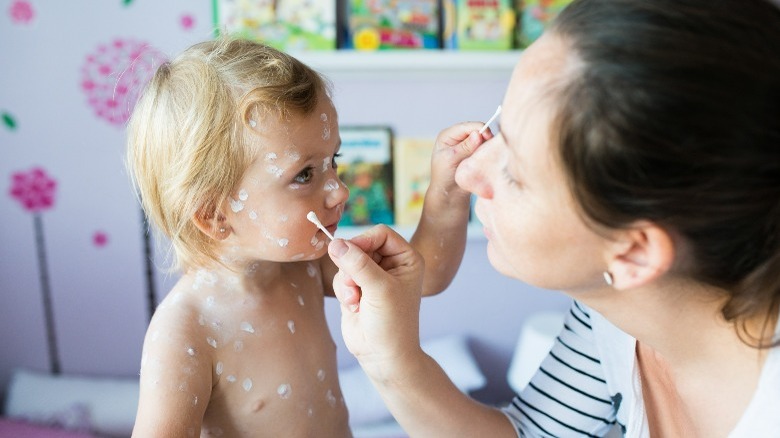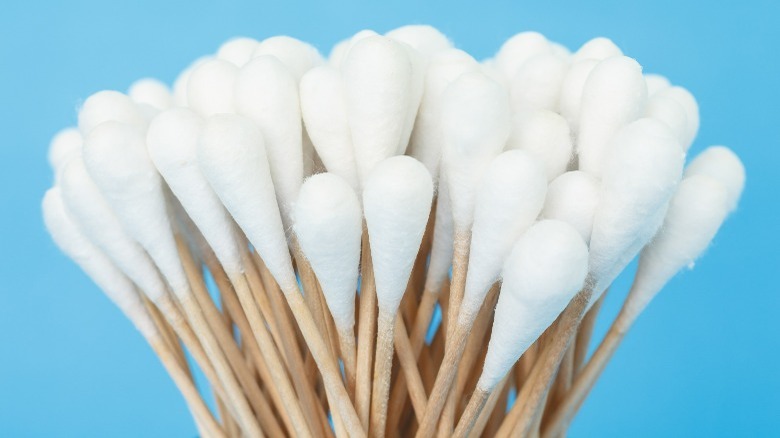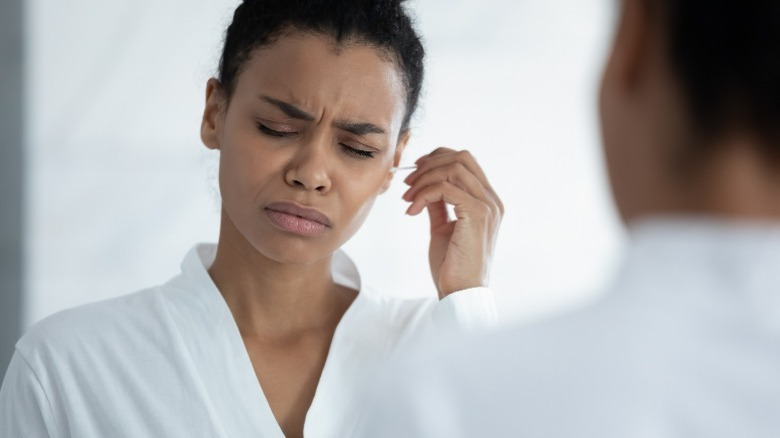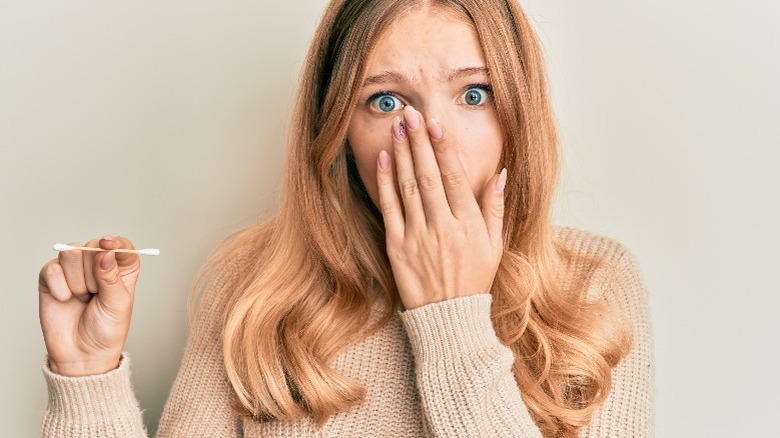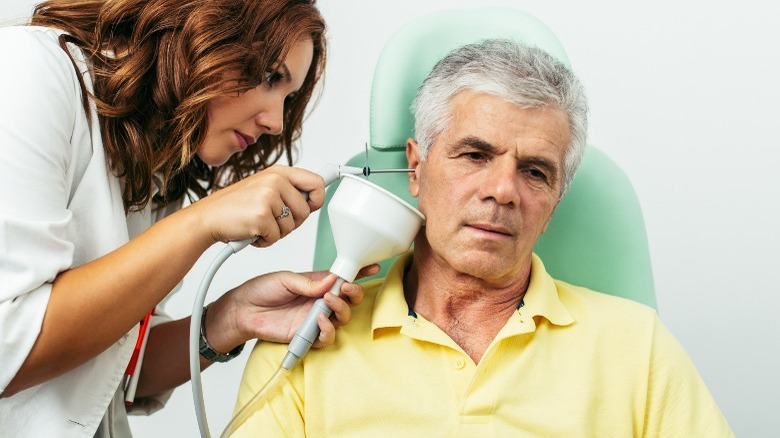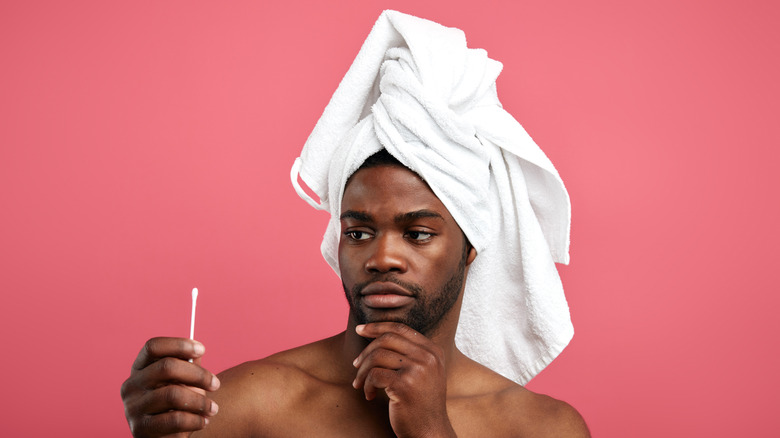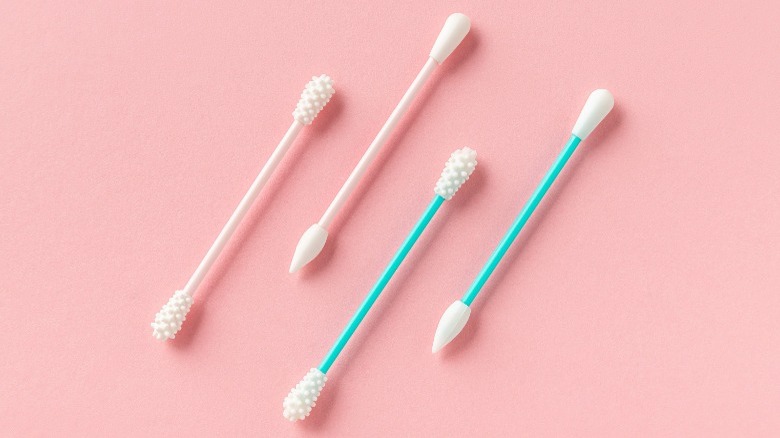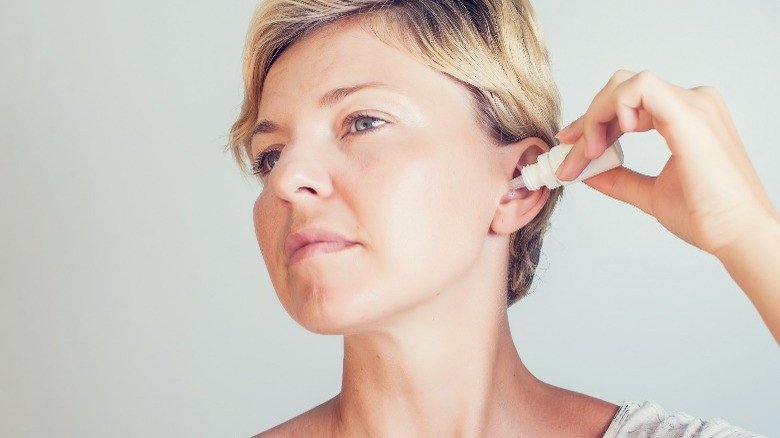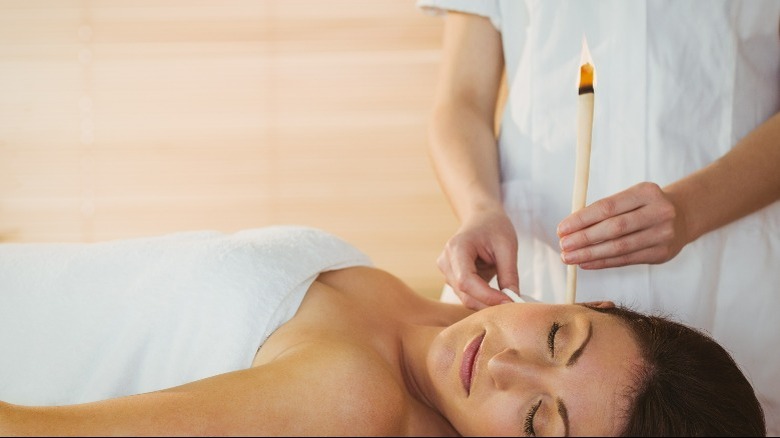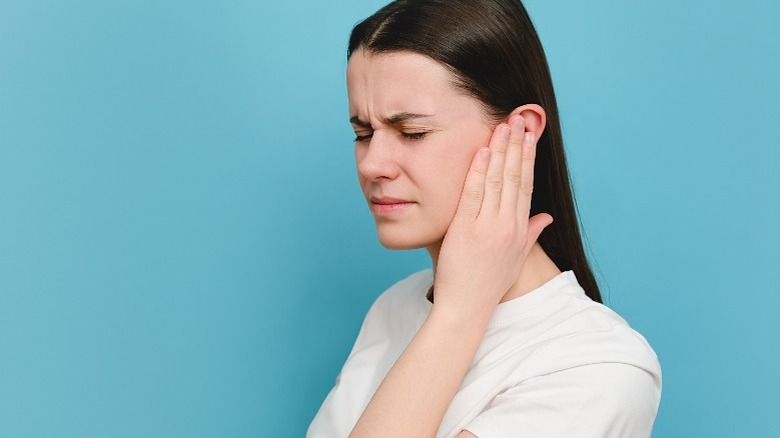You've Been Using Q-Tips The Wrong Way This Whole Time
We may receive a commission on purchases made from links.
We're all guilty of it: sticking Q-tips in our ears, despite being told repeatedly not to. The satisfaction of sopping up moisture inside our ears is akin to scratching a hard-to-reach itch. We know it's bad for us. Even the label on the back of the box cautions: "Do not insert swab into ear canal" (via CBS News). We do it anyway, compelled by the same compulsion as brushing our teeth or taking a shower. Plunging that cotton-tipped implement into our ears has practically become a cultural norm. But why?
The answer isn't so clear-cut. Perhaps what spurred the trend was the brand's early advertisements showing people using Q-tips (aka cotton swabs) to clean their ears — and then consumers adopted it into their daily hygiene routine. It makes sense, after all, that if there's an icky substance in our ears, we would want to go spelunking inside our skull to get rid of it. However, doing so is incredibly risky and dangerous. As Omid Mehdizadeh, a board-certified otolaryngologist at Pacific Neuroscience Institute, explained to Self, avoiding cotton swab-related injuries is "just the luck of the draw."
If Q-tips aren't the way to get clean ears, what's the secret? Spoiler alert: It's simpler than you might think. Keep scrolling to find out what makes Q-tips so controversial, why you should avoid putting them in your ears, and how to remove excess earwax the right way.
A brief history of Q-tips
Technically, this household staple came from the ingenuity of a woman — a mother, to be exact. After watching his wife clean their baby's ears using a toothpick with a cotton ball at the end, Leo Gerstenzang, a Polish-American inventor, decided to take the idea mainstream, creating a ready-made ear-cleaning instrument for everyday hygiene (via The Washington Post). And so, in 1923, the Q-tip — or, as it was originally called, Baby Gays — was born.
Over the decades, the product went through several name changes. It was eventually shortened to Q-tips, the "Q" ostensibly standing for "quality," according to a spokesperson for Unilever, the consumer goods company that now owns the Q-tips brand (via CNN Business). The design also evolved to better suit consumers' needs, progressing from a long wooden stick with cotton only at one end to a shorter, more flexible device (made of either paper or plastic) with double-sided cotton.
Despite these advancements, the product's marketing remained unchanged. It wasn't until the 1970s, nearly 50 years after Gerstenzang's invention, that the advertising for Q-tips finally changed, discouraging consumers from sticking the object in their ears. But by then, it was too late. The only reason people seemed to want to buy Q-tips was to use them for the very thing the company had begun advocating against. As Aaron Calloway, a former brand manager at Unilever, told CNN, "It was just accepted that that's how people were using it," per CNN Business.
The inevitable Q-tip craze
By the 1950s, Q-tip ads weren't just marketing the product for ear care, but for everything under the sun — touching up makeup, cleaning nooks and crannies, grooming pets (bad idea!), and nursing injuries. While consumers have adopted many uses for Q-tips, images of people putting them in their ears held a powerful cultural sway.
In the early 1970s, when the brand's then-owner Chesebrough-Pond's finally added a warning label cautioning against improper Q-tip use, cotton swabs were already a staple of the beauty market (via CNN Business). At the same time, the company amped up its marketing messaging, touting Q-tips as a safe and effective product. Even Betty White became a spokesperson for Q-tips in the '70s and '80s, assuring consumers that "no swab is softer — or safer."
As of this writing, there isn't a direct link as to why Q-tips added a warning label. However, according to a 2005 study published in the Journal of the Royal Society of Medicine, "the first instances of medical concern over the use of cotton buds were in 1972," with reported cases of ruptured eardrums, infections and inflammation of the outer ear canal, and earwax impaction. The study also conducted a survey with 325 participants, asking for their reasons for using cotton swabs in their ears. The majority (52%) said it was "because it seems like a good idea." Looks like those Q-tip ads worked!
Yes, using Q-tips to clean ears is bad
When it comes to using cotton swabs in your ears, you may be asking yourself, What's the big deal? Think of it like this: Would you want to drive a car blindfolded? Of course not. Likewise, you don't want to risk serious injury by mining for earwax you can't see. Here's a good rule of thumb: Don't stick "anything smaller than your elbow" into your ear, physician David Stutz told Michigan Health.
The most significant reason is that trying to excavate earwax yourself could push the wax even deeper into your ear canal. This self-made dam causes earwax to harden, forming a type of plug against the eardrum. When this happens, it can lead to an earwax impaction or other injuries, such as hearing loss or a painful ear infection, since fluid can build behind the impaction. You can also perforate (or puncture) the eardrum and injure the tiny, delicate bones inside the inner ear canal that control hearing and balance (via Verywell Health).
In an interview with Self, Omid Mehdizadeh, a board-certified otolaryngologist at Pacific Neuroscience Institute, explained, "We typically see complications like people losing the cotton tip in the ear, traumatizing the ear canal and causing painful infections, or poking through the eardrum with a cotton swab." Ouch!
Earwax is normal, really
The human body's ability to heal itself and perform millions of daily self-maintaining activities is nothing short of astounding. So, that gooey substance inside your ears that you're so intent on scraping out is meant to be there. Believe it or not, it serves a vital purpose and will take care of itself if left alone.
Earwax coats the inside of your ears and protects them from such foreign invaders as dirt, dust, and germs, according to Verywell Health. The ears also have their own self-cleaning system. When the body is ready to dispel old earwax, it will move it through the ear canal, conveyor-belt style, by way of jaw motions like talking or chewing, notes the site. As the earwax reaches the outer ear, it dries out and usually flakes off, per Cleveland Clinic. If the ear requires any sort of cleaning, it's typically to remove dried earwax from the outer ear using a damp washcloth.
"People have been led to think that it's normal to clean their ears — they think that ear wax is dirty, that it's gross or unnecessary," Dennis Fitzgerald, an otolaryngologist and assistant professor at Thomas Jefferson University, told The Washington Post. "But that's not true at all."
Using Q-tips can be more dangerous (and costly) than you think
While earwax (or cerumen, in medical parlance) itself is not harmful, trying to remove it on your own can be. Research shows that the innocuous-seeming Q-tip has placed quite a burden on the healthcare system, causing roughly 12 million Americans to seek medical care for earwax-related issues each year (via Verywell Health). Additionally, a 2017 report by the American Academy of Otolaryngology — Head and Neck Surgery Foundation found that "nearly $50 million was spent by Medicare in 2012 for cerumen-related procedures, and cerumen impaction was a diagnosis in up to 5% of Medicare patients."
But these sorts of injuries aren't just afflicting the elderly or those with disabilities; children are also heading to the ER in alarming numbers. A 2017 study published in The Journal of Pediatrics reviewed U.S. emergency room department data from 1990 to 2010. It found that more than 263,000 children were treated for various conditions caused by incorrect cotton swab use. The most common injury was a punctured eardrum or a foreign object in the ear. "These injuries are all preventable," Kris Jatana, an otolaryngologist and lead author of the study, told Nationwide Children's Hospital. "Despite all the warning labels that many manufacturers put on products, it seems there still persists a misconception."
But why do Q-tips feel so darn good?
For some people, lightly touching the ear can be titillating, as it can be sensitive enough to (ahem) provoke sexual arousal. What many of us don't know is that putting a cotton-swabbed stick in our ears can produce a similar kind of pleasure. "There are actually four different cranial nerves that innervate the ear canal," otolaryngologist Abbas Anwar told Prevention. "Because all those nerve endings are packed within such a small space, it is a very sensitive area." That means some Q-tip fans aren't just drawn to the satisfaction of digging for earwax, but also the sensation of giving themselves a gentle ear massage.
One important nerve to consider here is the vagus nerve, the longest of the cranial nerves, which stems from the brain, travels through the head and neck, and branches off into the major abdominal organs (via Britannica). Also known as the X cranial nerve, the vagus nerve plays a vital role in autonomic functions (those we do automatically) such as breathing, digestion, and swallowing. The Cleveland Clinic also notes that the vagal nerves are the primary nerves of the parasympathetic nervous system, which is responsible for making us feel calm and balanced. Given that these branches of nerves travel through the most sensitive parts of the ear canal, it's no wonder some people reach for the Q-tip to stimulate that part of the body. To save your eardrums, try giving yourself a vagus nerve massage instead.
Are Q-tips addictive?
Not only does a squeaky-clean ear canal leave you vulnerable to harmful substances like bacteria and debris that can burrow deep into your inner ear and cause infection, but over-cleaning your ears can also make them dry and itchy. "A lot of people have a chronic feeling that their ears are irritated or itchy, and feel that a Q-tip relieves that feeling," Benjamin Tweel, an assistant professor of otolaryngology at the Icahn School of Medicine at Mount Sinai, told Men's Health. "In that sense, it's like scratching an itch." Some refer to this as the itch-scratch cycle: An irritation causes an itch, so we reflexively scratch, leading to further inflammation.
Internet forums, radio-show hosts, and even television skits have half-jokingly posed questions about the addictiveness of Q-tip use. Speaking to Healthline, Adarsh Vijay Mudgil, a board-certified dermatologist and dermatopathologist, elaborated on the itch-scratch cycle, explaining that when we scratch an itch, the body sends a pain signal to the brain, prompting it to release serotonin, also known as "the happy chemical." Nir Eyal, a bestselling author, wrote in The Atlantic that the common denominator with addictions is when the perceived solution to a problem becomes the problem, dubbing this phenomenon the "Q-Tip Effect." He also called on companies to be more responsible in their advertising, especially when they know their products can lead to harmful, addictive behavior.
The new guidelines for using cotton swabs
While cotton swab companies haven't done much to dissuade consumers from using their products incorrectly, save for warning labels, healthcare providers have taken additional measures to educate patients about the dos and don'ts of proper ear care. In 2017, the American Academy of Otolaryngology — Head and Neck Surgery Foundation updated its guidelines, stating that its primary purpose for doing so was "to help clinicians identify patients with cerumen impaction who may benefit from intervention and to promote evidence-based management."
Having such protocols in place is important because, as the guidelines note, people around the world want clean ears. According to two studies cited in the report, "about 90% of respondents believed that ears should be cleaned," and "the practice of cleaning one's ears has a strong familial influence, often beginning in childhood and continuing throughout adolescence into adulthood." In other words, ear cleaning is often a ritualistic hygiene practice ingrained at an early age. Unfortunately, many people have adopted the wrong methods for tending to their earwax, but it's never too late to establish healthier habits.
How to safely clean your ears
Now that you've been sufficiently warned about how not to clean your ears, let's talk about what you should be doing. For most people, ear maintenance is simple: Do nothing. Your ears will take care of themselves. But if you feel you absolutely must clean your ears, there are a couple of safe DIY methods.
In lieu of a Q-tip, try wrapping a tissue around your index finger and lightly wiping around your outer ear folds and the outer ear canal, keeping away from the inner ear (via Men's Health). And don't even think about twisting the tissue to make your own version of a Q-tip. The key is to avoid sticking anything in your ear unless done so by a medical professional.
If you think that you may have some hardened wax in the ear canal, you can use wax-dissolving solutions, such as hydrogen peroxide, mineral oil, baby oil, Debrox, or saline solution (per the Cleveland Clinic). Insert two to three drops of your chosen solution into the affected ear and lie on the opposite side to allow the solution to work its way through the ear canal. Once the wax softens, it will migrate on its own toward the outer ear canal, where it can be safely wiped away.
It's important to note that some people can produce excess earwax, according to Medical News Today. If you find that your ears are often full of gunk, it's best to see your doctor.
Ear-cleaning methods to avoid
While the internet is brimming with some terrific — and not so terrific — beauty hacks, there are no must-try, newfangled methods for removing earwax. You simply need to let your body do its thing — unless you suspect there's a more serious underlying condition, in which case you should see a healthcare provider. But that hasn't stopped some folks from coming up with creative — and wild! — ways to purge earwax.
At-home suction devices, such as WaxVac, are not considered safe or effective, notes the Cleveland Clinic. There are also spiral-tipped ear-cleaning gadgets that are not recommended by physicians. And although essential oils can alleviate certain conditions, they shouldn't go in your ears. As the Mayo Clinic reports, "There is no data that shows they are safe for earwax removal, or that they work."
But perhaps the most bizarre, and dangerous, home remedy is ear candling. This method involves inserting a hollow candlestick in your ear and lighting the exposed end, the idea being that the heat from the flame will create a suction seal that draws out earwax (per WebMD). In 2010, six years after ear candling came onto the holistic scene, the FDA deemed the technique "ineffective and risky," as it can cause burns and puncture the inside of the ear (per CBS News). Erich Voigt, an otolaryngologist and associate professor at NYU Langone Health, told Self, "I've also seen the wax heated and slide down onto the eardrum." No thank you!
When to see a doctor
If you have a slight buildup of earwax, it will usually resolve on its own by migrating to the outer ear and flaking off. If you are experiencing more serious symptoms, however — such as ear pain, itching of the ears, a feeling of fullness in the ear, ringing in the ear (tinnitus), hearing loss, dizziness, drainage, bleeding, or cough — you should seek medical attention immediately (per the Mayo Clinic).
A word of caution: Even if you're convinced that you have excess earwax, there's no way to know for certain without having a physician first look into your ears using specialized instruments, notes the Mayo Clinic. Sticking a cotton swab in your ear without knowing what you're doing can make the situation worse, pushing whatever earwax you do have closer to the eardrum. "The issue again is about not being able to see what you're doing if you try to stick something in your ear to fix it yourself," physician David Stutz told Michigan Health.
So next time you reach for a Q-tip, use it for one of its many intended purposes, and leave the ear cleaning to your body or the medical experts.
